Shuiguang Deng
VADTree: Explainable Training-Free Video Anomaly Detection via Hierarchical Granularity-Aware Tree
Oct 26, 2025Abstract:Video anomaly detection (VAD) focuses on identifying anomalies in videos. Supervised methods demand substantial in-domain training data and fail to deliver clear explanations for anomalies. In contrast, training-free methods leverage the knowledge reserves and language interactivity of large pre-trained models to detect anomalies. However, the current fixed-length temporal window sampling approaches struggle to accurately capture anomalies with varying temporal spans. Therefore, we propose VADTree that utilizes a Hierarchical Granularityaware Tree (HGTree) structure for flexible sampling in VAD. VADTree leverages the knowledge embedded in a pre-trained Generic Event Boundary Detection (GEBD) model to characterize potential anomaly event boundaries. Specifically, VADTree decomposes the video into generic event nodes based on boundary confidence, and performs adaptive coarse-fine hierarchical structuring and redundancy removal to construct the HGTree. Then, the multi-dimensional priors are injected into the visual language models (VLMs) to enhance the node-wise anomaly perception, and anomaly reasoning for generic event nodes is achieved via large language models (LLMs). Finally, an inter-cluster node correlation method is used to integrate the multi-granularity anomaly scores. Extensive experiments on three challenging datasets demonstrate that VADTree achieves state-of-the-art performance in training-free settings while drastically reducing the number of sampled video segments. The code will be available at https://github.com/wenlongli10/VADTree.
SatFusion: A Unified Framework for Enhancing Satellite IoT Images via Multi-Temporal and Multi-Source Data Fusion
Oct 09, 2025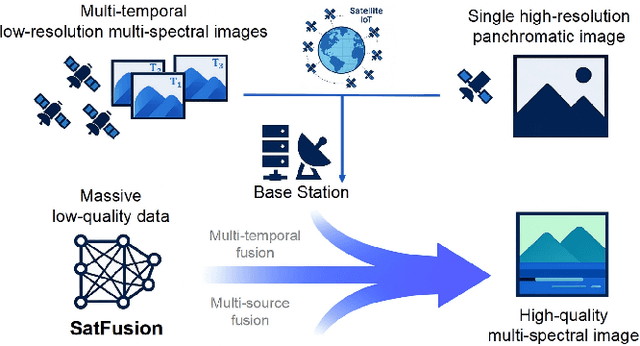
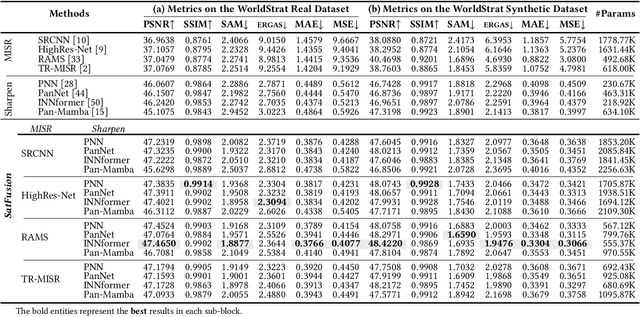
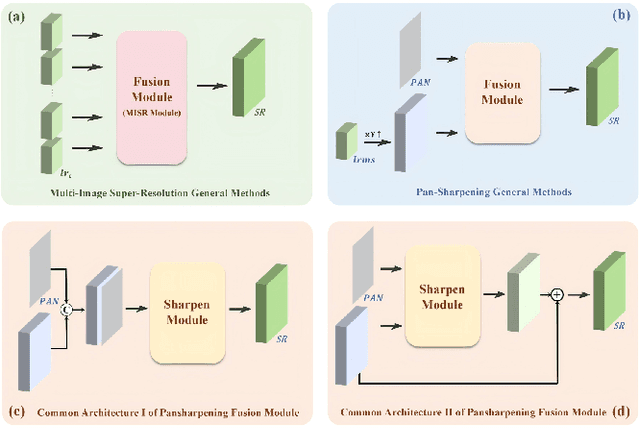
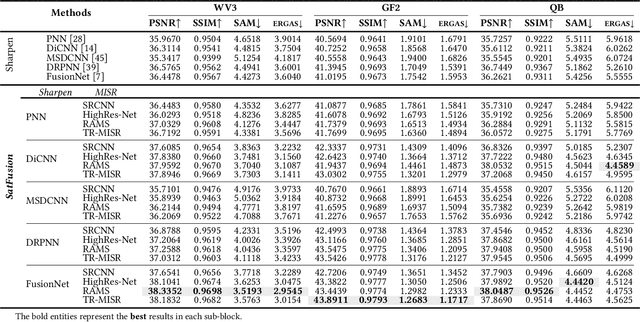
Abstract:With the rapid advancement of the digital society, the proliferation of satellites in the Satellite Internet of Things (Sat-IoT) has led to the continuous accumulation of large-scale multi-temporal and multi-source images across diverse application scenarios. However, existing methods fail to fully exploit the complementary information embedded in both temporal and source dimensions. For example, Multi-Image Super-Resolution (MISR) enhances reconstruction quality by leveraging temporal complementarity across multiple observations, yet the limited fine-grained texture details in input images constrain its performance. Conversely, pansharpening integrates multi-source images by injecting high-frequency spatial information from panchromatic data, but typically relies on pre-interpolated low-resolution inputs and assumes noise-free alignment, making it highly sensitive to noise and misregistration. To address these issues, we propose SatFusion: A Unified Framework for Enhancing Satellite IoT Images via Multi-Temporal and Multi-Source Data Fusion. Specifically, SatFusion first employs a Multi-Temporal Image Fusion (MTIF) module to achieve deep feature alignment with the panchromatic image. Then, a Multi-Source Image Fusion (MSIF) module injects fine-grained texture information from the panchromatic data. Finally, a Fusion Composition module adaptively integrates the complementary advantages of both modalities while dynamically refining spectral consistency, supervised by a weighted combination of multiple loss functions. Extensive experiments on the WorldStrat, WV3, QB, and GF2 datasets demonstrate that SatFusion significantly improves fusion quality, robustness under challenging conditions, and generalizability to real-world Sat-IoT scenarios. The code is available at: https://github.com/dllgyufei/SatFusion.git.
Edge Intelligence with Spiking Neural Networks
Jul 18, 2025Abstract:The convergence of artificial intelligence and edge computing has spurred growing interest in enabling intelligent services directly on resource-constrained devices. While traditional deep learning models require significant computational resources and centralized data management, the resulting latency, bandwidth consumption, and privacy concerns have exposed critical limitations in cloud-centric paradigms. Brain-inspired computing, particularly Spiking Neural Networks (SNNs), offers a promising alternative by emulating biological neuronal dynamics to achieve low-power, event-driven computation. This survey provides a comprehensive overview of Edge Intelligence based on SNNs (EdgeSNNs), examining their potential to address the challenges of on-device learning, inference, and security in edge scenarios. We present a systematic taxonomy of EdgeSNN foundations, encompassing neuron models, learning algorithms, and supporting hardware platforms. Three representative practical considerations of EdgeSNN are discussed in depth: on-device inference using lightweight SNN models, resource-aware training and updating under non-stationary data conditions, and secure and privacy-preserving issues. Furthermore, we highlight the limitations of evaluating EdgeSNNs on conventional hardware and introduce a dual-track benchmarking strategy to support fair comparisons and hardware-aware optimization. Through this study, we aim to bridge the gap between brain-inspired learning and practical edge deployment, offering insights into current advancements, open challenges, and future research directions. To the best of our knowledge, this is the first dedicated and comprehensive survey on EdgeSNNs, providing an essential reference for researchers and practitioners working at the intersection of neuromorphic computing and edge intelligence.
LightRouter: Towards Efficient LLM Collaboration with Minimal Overhead
May 22, 2025Abstract:The rapid advancement of large language models has unlocked remarkable capabilities across a diverse array of natural language processing tasks. However, the considerable differences among available LLMs-in terms of cost, performance, and computational demands-pose significant challenges for users aiming to identify the most suitable model for specific tasks. In this work, we present LightRouter, a novel framework designed to systematically select and integrate a small subset of LLMs from a larger pool, with the objective of jointly optimizing both task performance and cost efficiency. LightRouter leverages an adaptive selection mechanism to identify models that require only a minimal number of boot tokens, thereby reducing costs, and further employs an effective integration strategy to combine their outputs. Extensive experiments across multiple benchmarks demonstrate that LightRouter matches or outperforms widely-used ensemble baselines, achieving up to a 25% improvement in accuracy. Compared with leading high-performing models, LightRouter achieves comparable performance while reducing inference costs by up to 27%. Importantly, our framework operates without any prior knowledge of individual models and relies exclusively on inexpensive, lightweight models. This work introduces a practical approach for efficient LLM selection and provides valuable insights into optimal strategies for model combination.
Sage Deer: A Super-Aligned Driving Generalist Is Your Copilot
May 15, 2025Abstract:The intelligent driving cockpit, an important part of intelligent driving, needs to match different users' comfort, interaction, and safety needs. This paper aims to build a Super-Aligned and GEneralist DRiving agent, SAGE DeeR. Sage Deer achieves three highlights: (1) Super alignment: It achieves different reactions according to different people's preferences and biases. (2) Generalist: It can understand the multi-view and multi-mode inputs to reason the user's physiological indicators, facial emotions, hand movements, body movements, driving scenarios, and behavioral decisions. (3) Self-Eliciting: It can elicit implicit thought chains in the language space to further increase generalist and super-aligned abilities. Besides, we collected multiple data sets and built a large-scale benchmark. This benchmark measures the deer's perceptual decision-making ability and the super alignment's accuracy.
SRMF: A Data Augmentation and Multimodal Fusion Approach for Long-Tail UHR Satellite Image Segmentation
Apr 28, 2025Abstract:The long-tail problem presents a significant challenge to the advancement of semantic segmentation in ultra-high-resolution (UHR) satellite imagery. While previous efforts in UHR semantic segmentation have largely focused on multi-branch network architectures that emphasize multi-scale feature extraction and fusion, they have often overlooked the importance of addressing the long-tail issue. In contrast to prior UHR methods that focused on independent feature extraction, we emphasize data augmentation and multimodal feature fusion to alleviate the long-tail problem. In this paper, we introduce SRMF, a novel framework for semantic segmentation in UHR satellite imagery. Our approach addresses the long-tail class distribution by incorporating a multi-scale cropping technique alongside a data augmentation strategy based on semantic reordering and resampling. To further enhance model performance, we propose a multimodal fusion-based general representation knowledge injection method, which, for the first time, fuses text and visual features without the need for individual region text descriptions, extracting more robust features. Extensive experiments on the URUR, GID, and FBP datasets demonstrate that our method improves mIoU by 3.33\%, 0.66\%, and 0.98\%, respectively, achieving state-of-the-art performance. Code is available at: https://github.com/BinSpa/SRMF.git.
Facilitate Collaboration between Large Language Model and Task-specific Model for Time Series Anomaly Detection
Jan 10, 2025

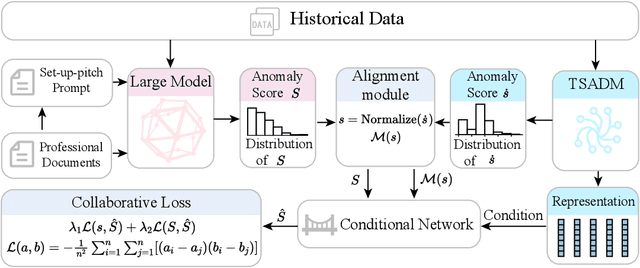
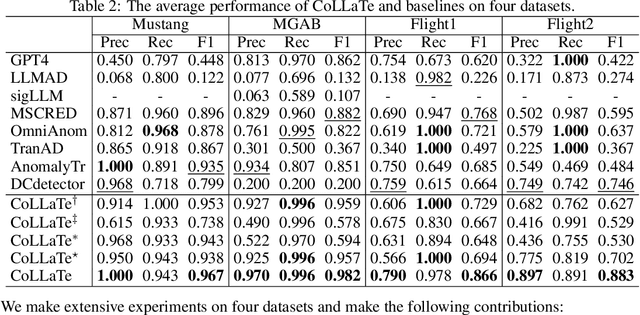
Abstract:In anomaly detection, methods based on large language models (LLMs) can incorporate expert knowledge, while task-specific smaller models excel at extracting normal patterns and detecting value fluctuations. Inspired by the human nervous system, where the brain stores expert knowledge and the peripheral nervous system and spinal cord handle specific tasks like withdrawal and knee-jerk reflexes, we propose CoLLaTe, a framework designed to facilitate collaboration between LLMs and task-specific models, leveraging the strengths of both. In this work, we first formulate the collaboration process and identify two key challenges in the collaboration between LLMs and task-specific models: (1) the misalignment between the expression domains of LLMs and smaller models, and (2) error accumulation arising from the predictions of both models. To address these challenges, we introduce two key components in CoLLaTe: the alignment module and the collaborative loss function. Through theoretical analysis and experimental validation, we demonstrate that these components effectively mitigate the identified challenges and achieve better performance than LLM based methods and task-specific smaller model.
SeMi: When Imbalanced Semi-Supervised Learning Meets Mining Hard Examples
Jan 10, 2025



Abstract:Semi-Supervised Learning (SSL) can leverage abundant unlabeled data to boost model performance. However, the class-imbalanced data distribution in real-world scenarios poses great challenges to SSL, resulting in performance degradation. Existing class-imbalanced semi-supervised learning (CISSL) methods mainly focus on rebalancing datasets but ignore the potential of using hard examples to enhance performance, making it difficult to fully harness the power of unlabeled data even with sophisticated algorithms. To address this issue, we propose a method that enhances the performance of Imbalanced Semi-Supervised Learning by Mining Hard Examples (SeMi). This method distinguishes the entropy differences among logits of hard and easy examples, thereby identifying hard examples and increasing the utility of unlabeled data, better addressing the imbalance problem in CISSL. In addition, we maintain a class-balanced memory bank with confidence decay for storing high-confidence embeddings to enhance the pseudo-labels' reliability. Although our method is simple, it is effective and seamlessly integrates with existing approaches. We perform comprehensive experiments on standard CISSL benchmarks and experimentally demonstrate that our proposed SeMi outperforms existing state-of-the-art methods on multiple benchmarks, especially in reversed scenarios, where our best result shows approximately a 54.8\% improvement over the baseline methods.
Gradient Purification: Defense Against Poisoning Attack in Decentralized Federated Learning
Jan 08, 2025



Abstract:Decentralized federated learning (DFL) is inherently vulnerable to poisoning attacks, as malicious clients can transmit manipulated model gradients to neighboring clients. Existing defense methods either reject suspicious gradients per iteration or restart DFL aggregation after detecting all malicious clients. They overlook the potential accuracy benefit from the discarded malicious gradients. In this paper, we propose a novel gradient purification defense, named GPD, that integrates seamlessly with existing DFL aggregation to defend against poisoning attacks. It aims to mitigate the harm in model gradients while retaining the benefit in model weights for enhancing accuracy. For each benign client in GPD, a recording variable is designed to track the historically aggregated gradients from one of its neighbors. It allows benign clients to precisely detect malicious neighbors and swiftly mitigate aggregated malicious gradients via historical consistency checks. Upon mitigation, GPD optimizes model weights via aggregating gradients solely from benign clients. This retains the previously beneficial portions from malicious clients and exploits the contributions from benign clients, thereby significantly enhancing the model accuracy. We analyze the convergence of GPD, as well as its ability to harvest high accuracy. Extensive experiments over three datasets demonstrate that, GPD is capable of mitigating poisoning attacks under both iid and non-iid data distributions. It significantly outperforms state-of-the-art defenses in terms of accuracy against various poisoning attacks.
FedLEC: Effective Federated Learning Algorithm with Spiking Neural Networks Under Label Skews
Dec 23, 2024Abstract:With the advancement of neuromorphic chips, implementing Federated Learning (FL) with Spiking Neural Networks (SNNs) potentially offers a more energy-efficient schema for collaborative learning across various resource-constrained edge devices. However, one significant challenge in the FL systems is that the data from different clients are often non-independently and identically distributed (non-IID), with label skews presenting substantial difficulties in various federated SNN learning tasks. In this study, we propose a practical post-hoc framework named FedLEC to address the challenge. This framework penalizes the corresponding local logits for locally missing labels to enhance each local model's generalization ability. Additionally, it leverages the pertinent label distribution information distilled from the global model to mitigate label bias. Extensive experiments with three different structured SNNs across five datasets (i.e., three non-neuromorphic and two neuromorphic datasets) demonstrate the efficiency of FedLEC. Compared to seven state-of-the-art FL algorithms, FedLEC achieves an average accuracy improvement of approximately 11.59\% under various label skew distribution settings.
 Add to Chrome
Add to Chrome Add to Firefox
Add to Firefox Add to Edge
Add to Edge